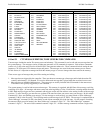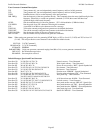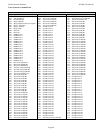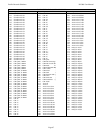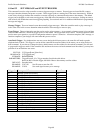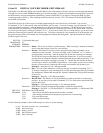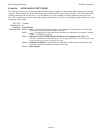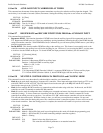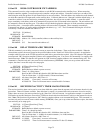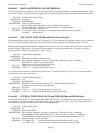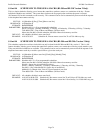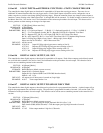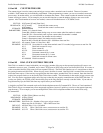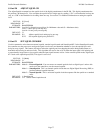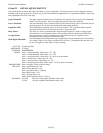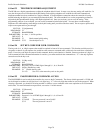
Pacific Research Solutions RI-300e User Manual
Page 72
S-Cmd 39 RI-300 CONTROLLER UNIT ADDRESS
This command is used to assign a unique unit address to each RI-300 connected on the Auxiliary buss. When connecting
multiple controllers together, you must assign each controller a unique unit address. Controllers on the buss can talk to each
other using the serial data protocol if each controller has its own unit address. This unit address also defines the audio channel
on which the controller will output audio on the auxiliary buss. Valid unit addresses are 1 through 9 with the default being 1. A
controller at address 9 can send and receive commands on the buss, but will not use an audio channel. A controller with a
macro containing a unit address with an S-Command will not process the S-Command in that controller. The unit address and
S-Command is sent to the auxiliary port. This address will be checked against the addresses of all the controllers connected to
the auxiliary buss. A controller with a matching address will execute the S-Command. These externally executable S-
Commands start with an “A” prefix and the destination unit address, e.g.: “A2”. The S-Command following the A2 will be
executed by a controller with the unit address of “2”.
SYNTAX: 39 [Address]
READ BACK: 39
STORAGE: RAM/EEPROM
PARAMETERS: Address 1-9 = Unit (controller) address on the auxiliary buss
DEFAULT: 1
EXAMPLE: 39 3 Sets controller unit address to 3.
S-Cmd 40 DELAY TIMER MACRO TRIGGER
With this command, you can delay a macro to execute at some time in the future. There are 8 timers available. When the
selected timer expires, the macro located at the specified address in the “Start Line” field will be executed. An application
example could be to turn on the CTCSS repeater tone panel after a preset time has expired. Note: This function will generate
an unexpected “OK” (function complete) without a user command being sent. You can use S-Command 06 1 to suppress this
function message.
Note:
This function will generate an “OK” function complete without a user command being sent. This
command is a one time only and is not stored in non-volatile memory (EEPROM). Once you set up a timer and the timer
expires, the timer is reset and ready to be setup again.
SYNTAX: 40 [Timer] [Start Line] [Time]
READ BACK: 40 [Timer]
STORAGE: RAM (Return to default at power on reset)
PARAMETERS: Timer 1–8 = Delay timers
Start Line 000 = Disable this function, 001–999 Macro data start line
Time 0 = Reset timer, 1–43,200 seconds (12 hours maximum)
DEFAULT: All timers, Start Line = 000, Time = 0
EXAMPLE: 40 1 000 0 Clear timer 1, no macro will execute.
40 2 060 120 Timer 2 will execute macro at start line 60 in 2 minutes.
S-Cmd 41 RECEIVER INACTIVITY TIMER MACRO TRIGGER
The receiver inactivity timer can be used to set an item within the system when the repeater receiver becomes inactive for the
preset time. There are 8 timers available. Once this timer is started, it is restarted after each occurrence of receiver activity.
When a time-out occurs, the macro pointed to by the “Start Line” field will execute. An application example: A controller in
COS mode can use this function to turn on the CTCSS tone decode after there has been no activity on the repeater for the set
time.
Note:
This function will generate an “OK” function complete without a user command being sent. This command is a
one time only and is not stored in non-volatile memory (EEPROM). Once you set up a timer and the timer expires, the timer is
reset and ready to be setup again.
SYNTAX: 41 [Timer] [Start Line] [Time]
READ BACK: 41 [Timer]
STORAGE: RAM (Return to default at power on reset)
PARAMETERS: Timer 1–8 = Inactivity timers
Start Line 000 = Disable this function, 001 – 999 Macro data start line.
Time 0 = Reset timer, 1–14400 in 6 second increments (1 to 1440.0 minutes).
DEFAULT: All 8 timers, Start Line = 000, Time = 0.
EXAMPLE: 41 1 000 0 Clear timer 1, no macro will execute.
41 2 022 55 Timer 2 will execute macro at start line 22 after 5.5 minutes.



